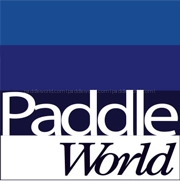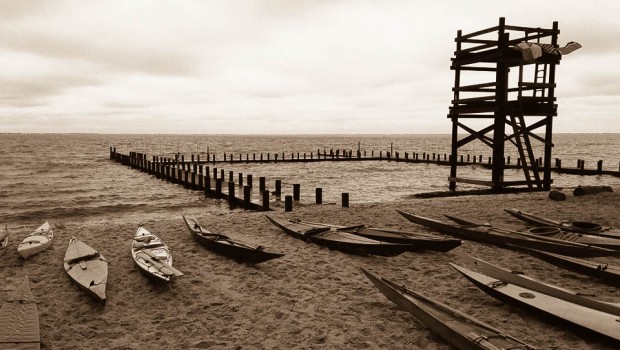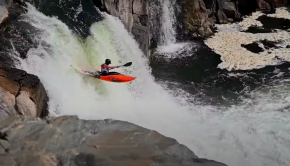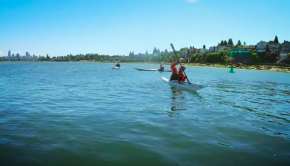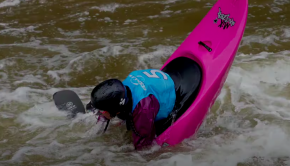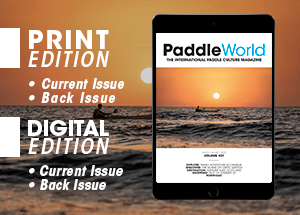The Increasing Number of Traditional Paddling Events Worldwide
By: Christopher Crowhurst
Across the United States and around the globe new traditional paddling events are appearing. Many commercial events are taking advantage of the growth in popularity of the Greenland paddle and Greenland kayaks and including focused sessions to attract these passionate paddlers. It is perhaps a little unfortunate that the main area that these events focus on is Greenland style rolling. The Greenland qajaq culture encompass many more aspects of the Inuit life, including qajaq building, paddling carving, harpooning and learning to paddle silently and efficiently with the skinny stick. Qajaq USA recently unanimously elected three new advisers, including me, to the board. The board is embarking on an effort to energize the membership, to ensure Qajaq USA remains relevant in the face of stiff commercial competition. A great deal of discussion is taking place on how best to promote the broader aspects of the Qajaq culture and prevent the organization and sport from being pigeon holed into those people with skinny sticks who roll a lot. In an effort to show support for the organization’s mission, as well as my own passion for the Qajaq Culture, and to learn more about Qajaq USA and its history I attended three of the six sanctioned events this year.
Delmarva Paddler’s Retreat
The event that started it all. Delmarva was where Qajaq USA was formed, this year was the 26th annual holding of this significant event on the annual traditional paddling Calendar. Each year the Qajaq USA board meets at Delmarva to help move the organization forward and support its mission to promote the appreciation of the Greenland Qajaq Culture within the USA.
The location is on the East side of the United States roughly halfway up the coast on a protected inland waterway near the popular beaches of Rehoboth in Delaware. This year roughly fifty people descended upon Camp Arrowhead, a small traditional camp ground with multi-room huts, a large dinning hall and many other facilities dotted around the property’s secluded woodlands. The perfect white sandy beach gently shelves down into the warm salty Atlantic Ocean fed waters of Rehoboth Bay.
On the beach stands a small wooden tower from which one can survey the goings on afloat. The tower is an iconic feature of any photograph of the event, it is captured beautifully by this photograph taken by Madi Murphy one of the younger, regular, attendees at Delmarva.

Delmarva Paddler’s Retreat at Camp Arrowhead, Lewes, DE. Image courtesy of Madi Murphy
With excellent on-land and on-water programs, evening entertainment, relaxing accommodations, and plentiful food, this event’s only drawback is the two plus hours it takes to get to from the nearest major airport. The on-water sessions are all announced the day before and people get the opportunity to sign up ahead of time. This gives the organizers the chance to see what is popular and ensure there are sufficient mentors assigned to each group of paddlers.
I ran three Storm Roll sessions and one session that I call Bomb-Proofing. All of the sessions were filled to capacity. The Bomb-Proofing session was a great success and we helped a number of paddlers understand how their performance changes when their bodies, breathing, and mind becomes under pressure and stress. We aim to push them to the point of failure, so they can experience what that feels like. We were fortunate to have some slight sea conditions. A stiff breeze had picked up Rehoboth bay and it had confused one foot waves, just high enough to cause a few unexpected face-fulls of water, but not enough to create dangerous situations when we had to rescue and recover people from failed rolls. It can be hard work for the mentors to maintain communication and safety, we were fortunate that sufficient mentors volunteered to allow us to work one-on-one with each paddler.
The last activity I took part in was organized by Dubside. He had created a set of rules for a team rolling competition. I helped form Team Europe with Renee DuFresne and Anders Thygesen. We ended up loosing, we had not all fully understood the nuances of the rules and hence pitted the wrong rollers against each other, but we put up a valiant effort. Our team rolled in qajaqs from the Qajaq USA fleet, replicas of different traditional Greenland skin on frames, and used paddles from the fleet too. The other team all used plastic Tahe Marine Greenland kayaks so we gave them a hard time about it, calling them Team Popsicle. It was a great time, and I was fortunate enough to meet many new friends and thoroughly enjoyed the supportive and passionate experience.
You can find information about the Delmarva Paddler’s Retreat on their website delmarvapaddlersretreat.org
Traditional Gathering
The Gathering, as we call it in Minnesota, was originally just that, a gathering of enthusiast who shared their passion for traditional qajaq building and paddling. Since its early days it has grown and has become a Qajaq USA sanctioned event. For the past few years the Gathering has taken place in the mid-west of Minnesota on Lake Carlos which is near the city of Alexandria. Located at the sheltered northern end of the lake nestled in amongst the maple trees of Lake Carlos State Park the camp ground has basic cabins and a large meeting room with a kitchen. This is the smallest of the three events, the capacity is limited by the accommodations and this allows the event to remain an a more intimate event with many long term friendships established and maintained. Unlike the other Qajaq USA events the Gathering does not provide food so each paddler need to be self sufficient, there is a fully functioning kitchen with cold room and the grill is lit every night.
The Gathering has sessions for rolling, harpooning and strokes and maneuvers. It is also the only event I am aware of in the USA that holds an annual harpoon competition. It is interesting how this event has driven a rise in the popularity of harpooning amongst mid-west paddlers. I counted nearly a dozen people arriving with their own equipment, a far cry from the other events where it is rare to see a harpoon thrown let alone a mentoring session to help people.
Like most Qajaq USA events one or more outside mentors are invited to attend, this year Helen Wilson and Greg Stammer attended. Having Greg there was particularly helpful in providing an alternative to rolling with his Forward Strokes class, as well as giving a presentation on some of his expeditions with Greenland paddles and kayaks.

Traditional Gathering at Lake Carlos, MN.
Access to the lake has historically been challenging, with the qajaqs needing to be carried down a steep rocky bank. This year the State Park has established a small dock which allowed much easier and safer access to the water from the camp. Being located in Alexandria, the Gathering is a long drive or plane ride for nearly everyone that attends. This year we had a paddler come all the way from North Carolina, real dedication to her passion.
You can find information about the Traditional Gathering on their website qajaqmn.org
Michigan Training Camp
Training Camp is held on the Eastern shore of Lake Michigan. Camp lookout is located on a large sand dune that separates Lower Herring Lake from the much larger and potent Lake Michigan. A series of wooden docks provide easy access to the shallow sheltered waters of Lower Herring Lake and a channel leads into the big lake. The on water activities generally take place in the small lake. The exception occurs when the weather cooperates and kicks up surf on the outer shores. This year we were not fortunate enough to be granted surfing conditions so mostly we worked in the sheltered waters. Greenland Ropes Gymnastics feature heavily at the event, especially in the evening when they tend to be a focal point for people to congregate and experiment under the watchful eyes of the ropes mentors.
Training Camp evenings are particularly social times, camp fires on the beach, a before dinner happy hour and the main hall for ropes all allow new comers to easily assimilate into the group dynamics. The event is fully catered by a local paddler chef, unquestionably a highlight of the event are the outstanding meals Michael creates, and the obsession with great coffee is appreciated by the early risers amongst us.

Michigan Training Camp at Camp Lookout, Lower Herring Lake, MI.
Training camp usually includes harpooning and rolling afloat. This year I helped to run a “Turning with an extended paddle” session. We use this session to help people understand the subtle differences between the methods they may have learned to turn their kayak with a European paddle and how to maximize the use of the Greenland paddle to do the same maneuvers.
We also performed an education session where we demonstrated the four basic roll types, and their progressions to help remove the mystery behind how we do what we do.
The Training Camp organizers are working hard to establish a greater cadre of local mentors, so there was a mentor shadowing scheme in place which seemed to work well. I really enjoyed working along side the local mentors and showing them how I work and talk with paddlers as I help them progress.
You can find information about the Michigan Training Camp on their website qajaqtc.org
Qajaq USA is doing important work, helping to support and share knowledge and skills of the Inuit Qajaq Culture. If you are not already a member I would encourage you to join the organization, it is very cheap to do so and you get access to great resources and information. If you have never attended a Qajaq USA event I recommend you consider trying one in 2015. They are a very different experience compared to the Kayak Symposium and commercial events.
« About the author: Christopher Crowhurst is slightly obsessed with Greenland Rolling, an ex-pat Britt now living in Minnesota USA. In 2010 he founded Qajaq Rolls, a philanthropic business that promotes the passing on the traditional art of Greenland style kayak (qajaq) rolling. Christopher has developed video, diagrams and written instruction to help paddlers learn the traditional Greenland rolls. During 2010 he self-published Rolling with Sticks a waterproof guide book of twenty five Greenland style rolls, and followed this up with a companion DVD. In 2011 he used the business to establish and fund a program of free rolling clinics providing hands on training for paddlers looking to develop their Greenland style kayak rolls. You can contact Christopher through his website https://qajaqrolls.com«
